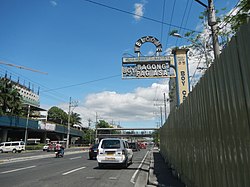
Quezon City, also known as the City of Quezon and Q.C., is the most populous city in the Philippines. According to the 2020 census, it has a population of 2,960,048 people. It was founded on October 12, 1939, and was named after Manuel L. Quezon, the second president of the Philippines.

Caloocan, officially the City of Caloocan, is a 1st class highly urbanized city in Metro Manila, Philippines. According to the 2020 census, it has a population of 1,661,584 people making it the fourth-most populous city in the Philippines.
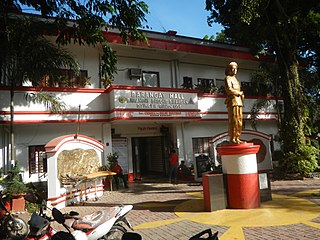
Bagong Silangan is a barangay located in the 2nd district of Quezon City, Philippines. Nearby barangays are Commonwealth, Batasan Hills and Payatas. Separated by a river in the east, the barangay leads to the Municipality of San Mateo in the province of Rizal.

Batasan Hills is a barangay of Quezon City, Philippines. The barangay was originally planned as the National Government Center of the Philippines. The Batasang Pambansa Complex, which sits atop the Constitution Hill, is the legislative session hall of the House of Representatives of the Philippines. The Sandiganbayan, a special appellate court, is also located here.

Greenhills is an administrative division in eastern Metro Manila, the Philippines. It is an urban barangay in San Juan and is the largest barangay in the city, covering a total area of 2.09 square kilometers (209 ha) that spans over a third of San Juan's total land area.

The San Juan River is one of the main river systems in Metro Manila, Philippines, and is a major tributary of the Pasig River. It begins near La Mesa Dam as the San Francisco del Monte River, which officially takes the name San Juan River when it meets with Mariblo Creek in Quezon City. As the San Juan River, it passes through Quezon City, San Juan, the Manila district of Santa Mesa and Santa Ana, and Mandaluyong.

Manuel L. Quezon Avenue, more often called as Quezon Avenue, or simply Quezon Ave, is a 6.1-kilometer (3.8 mi) major thoroughfare in Metro Manila named after President Manuel Luis Quezon, the second president of the Philippines. The avenue starts at the Quezon Memorial Circle and runs through to the Welcome Rotonda near the boundary of Quezon City and Manila.
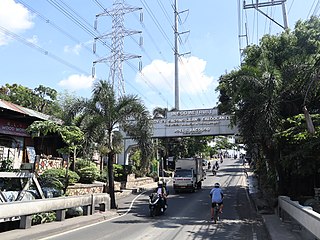
Bagong Silang or Barangay 176 is a barangay of Caloocan, Metro Manila, Philippines. It is known for being the most populous barangay in the Philippines, with a population of 261,729 according to the 2020 census. It is also the northernmost barangay of Metro Manila located in the northern section of the city bordering the province of Bulacan.
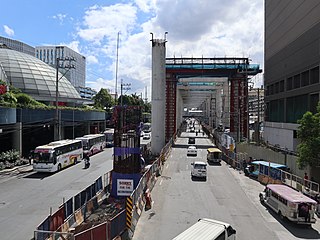
North Avenue is a major road located in Quezon City within the Diliman area of northeastern Metro Manila, Philippines. It runs east–west through barangays Bagong Pag-asa, Project 6, and Vasra, forming the northern part of the North Triangle area. The street is located in Quezon City's mixed-use and government area, known for its malls, condominiums, hotels, and the upcoming QC CBD. It is also home to SM North EDSA, Trinoma, and Ayala Malls Vertis North located on the avenue's junction with Epifanio de los Santos Avenue (EDSA). The entire avenue is designated as National Route 173 (N173) of the Philippine highway network.

Socorro is a barangay located in Quezon City, Philippines, within the commercial district of Cubao. As of the 2019 census, the barangay has a population of 25,073 people. The barangay is home to Araneta City and Smart Araneta Coliseum, one of the largest indoor arenas in the world.

Veterans Village, more commonly known as Project 7 and Muñoz, is a barangay located in Quezon City with an approximate land area of 51.941 hectares bounded by Barangay San Antonio in the Southwest, Fernando Poe Jr. Avenue in the West, Barangay Bungad in the Southeast and EDSA in the North.

West Avenue is a major road located in Quezon City within the Diliman area of northeastern Metro Manila, Philippines. It runs north–south through the western edge of the barangay of West Triangle. The street is located in Quezon City's commercial-residential area, known for its restaurants, car shops, schools, and villages. It is also home to the old Delta theater located on the avenue's junction with Quezon Avenue. The avenue is a component of National Route 171 (N171) of the Philippine highway network.

Bungad is an administrative division in eastern Metro Manila, the Philippines.
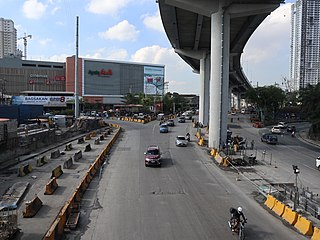
Balingasa, commonly known as Balintawak and Cloverleaf, is an administrative division in eastern Metro Manila, the Philippines. It is an urban barangay located in Quezon City, at the city's western boundary with Caloocan.

Santo Cristo (PSGC:) is a Quezon City barangay located in North EDSA, a busy commercial area of shopping malls, transport hubs and office buildings.

Project 6 is a barangay of the 1st legislative district of Quezon City, Metro Manila, Philippines. Project 6 is mainly a residential area with neighboring barangays having high-rise buildings like TriNoma, Ayala Malls Vertis North, Word of Hope Christian Family Church Main, and SM City North EDSA. Almost half of Project 6's land are attributed to Veterans Memorial Golf Course, located in the southern half of Project 6 where Veterans Memorial Medical Center could be found as well.

Philam, also known as Philam Homes, Philamlife Homes or Phil-Am, is an administrative division in eastern Metro Manila, the Philippines. It is an urban barangay located in the first legislative district of Quezon City, consisting entirely of the Philam private subdivision and gated community.

Tatalon is a barangay of Quezon City, Philippines. According to 2020 Census, it has a population of 55,404 people.
Frost Plan was the popular name for the Plan of Quezon City, co-authored by Juan M. Arellano and Harry Frost, together with Alpheus Williams and Louis Croft. The plan was approved in 1941, two years after the creation of Quezon City. The Plan was revised in 1949.
